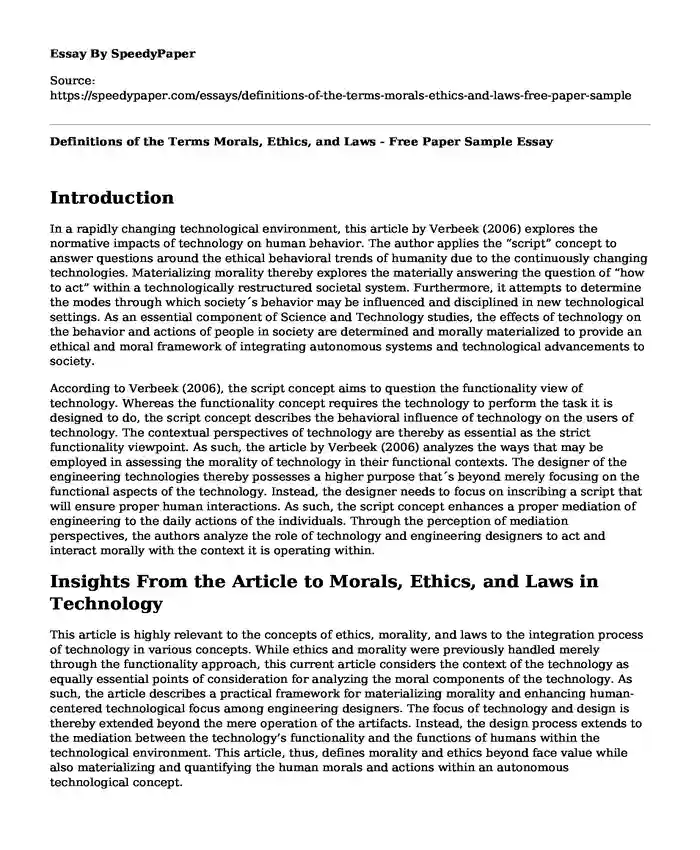
| Type of paper: | Essay |
| Categories: | Sociology Law Technology Ethics Moral development |
| Pages: | 3 |
| Wordcount: | 606 words |
Introduction
In a rapidly changing technological environment, this article by Verbeek (2006) explores the normative impacts of technology on human behavior. The author applies the “script” concept to answer questions around the ethical behavioral trends of humanity due to the continuously changing technologies. Materializing morality thereby explores the materially answering the question of “how to act” within a technologically restructured societal system. Furthermore, it attempts to determine the modes through which society´s behavior may be influenced and disciplined in new technological settings. As an essential component of Science and Technology studies, the effects of technology on the behavior and actions of people in society are determined and morally materialized to provide an ethical and moral framework of integrating autonomous systems and technological advancements to society.
According to Verbeek (2006), the script concept aims to question the functionality view of technology. Whereas the functionality concept requires the technology to perform the task it is designed to do, the script concept describes the behavioral influence of technology on the users of technology. The contextual perspectives of technology are thereby as essential as the strict functionality viewpoint. As such, the article by Verbeek (2006) analyzes the ways that may be employed in assessing the morality of technology in their functional contexts. The designer of the engineering technologies thereby possesses a higher purpose that´s beyond merely focusing on the functional aspects of the technology. Instead, the designer needs to focus on inscribing a script that will ensure proper human interactions. As such, the script concept enhances a proper mediation of engineering to the daily actions of the individuals. Through the perception of mediation perspectives, the authors analyze the role of technology and engineering designers to act and interact morally with the context it is operating within.
Insights From the Article to Morals, Ethics, and Laws in Technology
This article is highly relevant to the concepts of ethics, morality, and laws to the integration process of technology in various concepts. While ethics and morality were previously handled merely through the functionality approach, this current article considers the context of the technology as equally essential points of consideration for analyzing the moral components of the technology. As such, the article describes a practical framework for materializing morality and enhancing human-centered technological focus among engineering designers. The focus of technology and design is thereby extended beyond the mere operation of the artifacts. Instead, the design process extends to the mediation between the technology’s functionality and the functions of humans within the technological environment. This article, thus, defines morality and ethics beyond face value while also materializing and quantifying the human morals and actions within an autonomous technological concept.
As this piece describes technological morality through a mediation lens of the two worlds (traditional and modern), the author then explores the continually shifting ethical and moral considerations for human-machine interactions. The author, furthermore, focuses on the need to understand ethics and morality in technological and traditional contexts through descriptive and value-focused qualitative approaches. The designers and engineers are as such supposed to be both functionally and contextually sensitive during their technological innovations.
Conclusion
The most significant learning insights that were evident from this article was the need to focus not only on non-contextualized laws during innovations and human-machine interactions but to focus more on the values the innovations bring to human interactions. The technologies are supposed to respond to changing human behavior and shape their actions constructively through positive and human-centered interactions.
Reference
Verbeek, Peter-Paul. “Materializing Morality: Design Ethics and Technological Mediation.” Science, Technology, & Human Values, vol. 31, no. 3, 1 May 2006, pp. 361–380., doi:10.1177/0162243905285847.
Cite this page
Definitions of the Terms Morals, Ethics, and Laws - Free Paper Sample. (2023, Nov 10). Retrieved from https://speedypaper.com/essays/definitions-of-the-terms-morals-ethics-and-laws-free-paper-sample
Request Removal
If you are the original author of this essay and no longer wish to have it published on the SpeedyPaper website, please click below to request its removal:
- Essay Example on Presentation Skills on YouTube
- Essay Sample on Apple Inc.
- Paper Example. Child Abuse and Neglect
- Free Essay: Forum Security Risks and Changes in Law Enforcement
- Free Essay. Personal Persuasive Communication
- Brief Research Article Summary and Critique
- Planned Parenthood v. Casey: Navigating Abortion Rights and State Regulations in the U.S.
Popular categories




